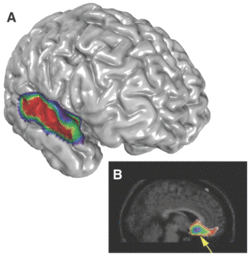A study of the brain provides at least a few clues regarding these questions. It is clear that the human brain has a highly developed capacity for processing music. It is difficult for me to believe that this very specialized capability evolved without an evolutionary benefit. However the benefit might not directly involve music. Pinker believes music does not serve an evolutionary purpose; he states: "As far as biological cause and effect are concerned, music is useless.....music could vanish from our species and the rest of our lifestyle would be virtually unchanged." He also states that music builds on language structures, implying that music evolved after language. Pinker is not alone in his opinion, but there is also no lack of experts who vigorously disagree.
Acknowledgement: much of the material in this section is derived from Levitin's book "This is your brain on music", and the book Musicophilia by Oliver Sacks. If you find this subject interesting, I also highly recommend the 52 minute YouTube lecture by Aniruddh Patel.
Rhythm
It is easy to imagine that rhythm was a very early form of musical expression. Anyone can pick up a stick, and rhythmically beat it against something. A universal human reaction is a synchronized motor response; foot tapping or other body movements. This appears to be (almost) a uniquely human trait. Sacks quotes Aniruddh Patel: "there is not a single report of an animal being trained to tap, peck, or move in synchrony with an auditory beat." However the Patel video I reference shows a bird that he now believes really is dancing. This linking of auditory and motor systems depends on interactions between the auditory and the dorsal premotor cortex, and only the human brain (or perhaps the birdbrain as well) has a functional connection between these areas. Patel goes on to argue that rhythm ".. cannot be explained as a by-product of linguistic rhythm" and must have evolved separately from speech.Rhythm can have a amazing unifying effect on a group of people. Anybody who has heard Stevie Wonder's rendition of "Fingertips," and the electrifying effect it had on the crowd, is aware of this. My son frequently participates in drum circles, and I vividly remember an experience I had many years ago in Yosemite National Park. A bunch of us were in a meadow, making random noises on various kinds of percussion instruments. After a few minutes somehow a unifying rhythm emerged. Everyone tuned into it and played ecstatically. I totally lost my sense of "I" and for a few fleeting minutes a ragtag mob became a single throbbing organism. A few other times in my life I have had a transcendent experience dancing to very loud, very rhythmic music, and it was intimately connected with the fact that I was one member of a group caught up in the same frenzy.
Another context where rhythm is a crucial unifying component (for better or for worse) is martial music, and some religious celebrations, such as gospel music.


No comments:
Post a Comment